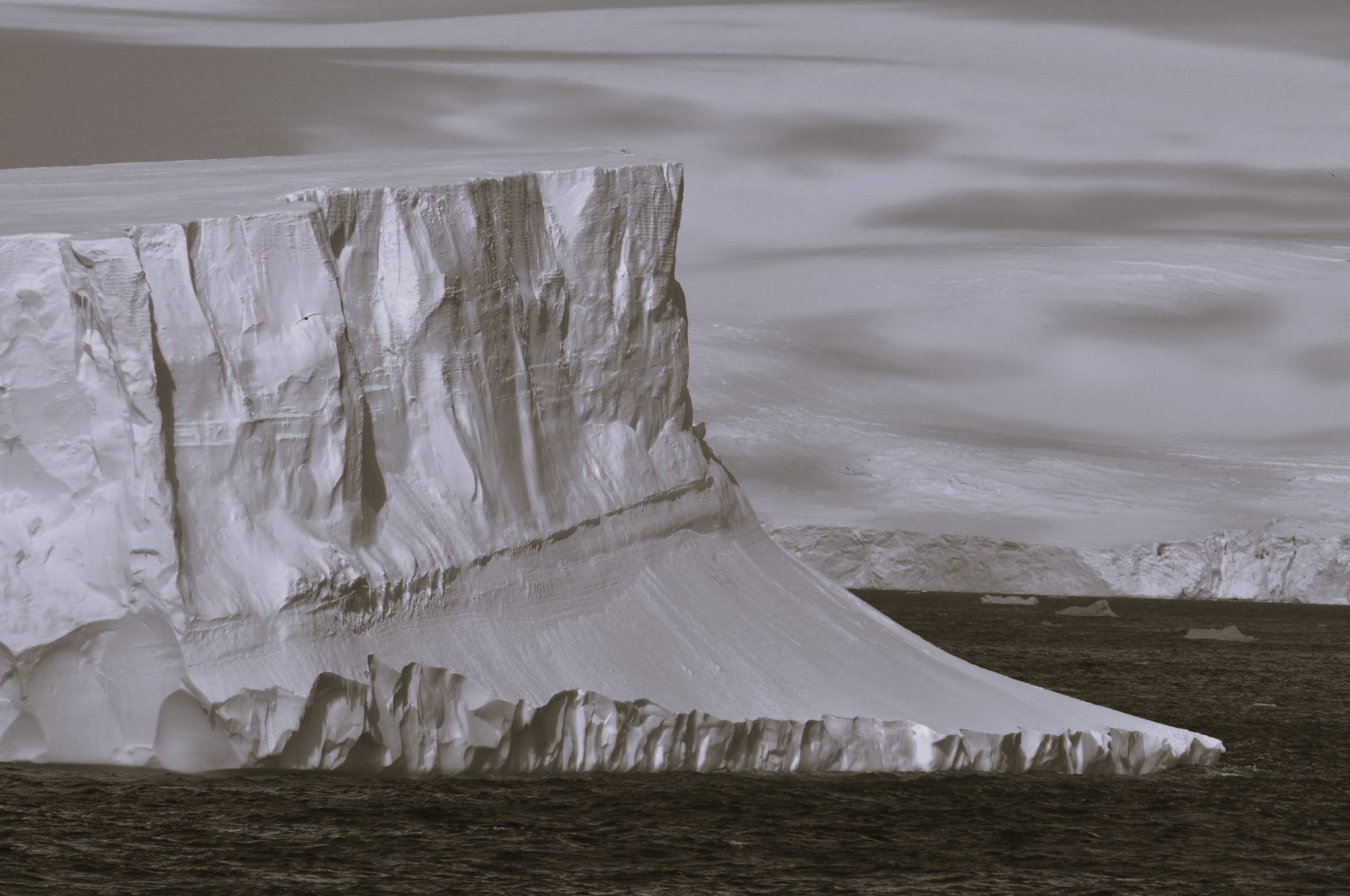At the Mountains of Madness
“Like a land of mystery in a dream.”
At The Mountains of Madness was accepted by an editor in 1936 and was published as a novella in the magazine that at the time was known as Astounding Stories, and has been under various other titles since. It was serialized, much like Charles Dickens’ novels in England, and appeared in three different issues of the magazine. It is the oldest and longest of the stories examined here, but it is also the one most concerned with archaeology and the one that displays a lot of the stereotypes that are still associated with this kind of horror and archaeology.
Lovecraft had this novella written much earlier, but due to the long length it was rejected and publication stalled for quite some time. As it is, this was published only a year before his death. It was not the last one he published, far from it, and many were published postmortem. This story seemed to be inspired partially by the exploration of Antarctica and The Narrative of Arthur Gordon Pym of Nantucket, a work by Edgar Allen Poe. The plot generally follows William Dyer, a professor from Miskatonic University.
The story is broken into multiple parts, which do not line up exactly with how the story was originally published.
Part I:
In part one, the narrator, Dyer, is stating that despite advice to the contrary, he is finally going to reveal the truth of what happened on his previous expedition to Antarctica. He is attempting to convince men of science that what he saw was real and that they should stop any more expeditions to the mountains of madness.
The expedition hoped to uncover a fair amount of material, believed to be the remnants of primal life-history and a key part of uncovering the earth’s past. They believed that the continent was once a thriving tropical continent.
The Miskatonic Expedition sent four University men: Pabodie, from Engineering, Lake, from Biology, Atwood from Physics, and Dyer from Geology, along with other members of the expedition who accompanied them. The beginning of the journey was fairly routine, as they simply had to make their way to Antarctica. When they arrived, the scene reminded Dyer of a strange painting by Nicholas Roerich, as well as the book the Necronomicon, which Dyer states he regrets reading.
Both works he references are foreign, which Lovecraft likely used to mean “exotic,” and this is a recurring theme and one that is likely derivative of Lovecraft’s own xenophobia and “othering” of places he would have considered “exotic” - things that are notably something that modern archaeologists attempt to avoid at all costs.
Dyer then directly references Edgar Allan Poe in the text, who wrote at story featuring Antarctica as well, which Danforth points out. Danforth is a main character moving forward, and he is said to read “bizarre material,” which Dyer implies includes Poe’s works.
The team sets up a barrier camp and they begin to explore the surrounding area. They set up a new base camp and begin to conduct scientific experiments. They also make observation flights, which convince them to establish yet another base and a new place to search for geological specimens. It is at this point that odd things start to happen, as Lake is convinced there is a new pre-Cambrian specimen to document in the area, which Dyer states must have been over 500 million years old.

Part II:
Dyer begins the second part by stating that those back home responded to their reports back with wild thoughts of places beyond human touch and human imagination, but that Dyer did not expect to revolutionize the sciences. Lake diverged from the others at this point and from then on had a separate expedition. During this, it is clear that his excitement for new knowledge has surpassed reason, and we start to see the first signs of madness.
At some point, Lake’s plane was forced down and stated that they had found something like a gateway to a forbidden world. The rest of Part II is a set of transmissions to and from the two expeditions. Lake starts to send very excited messages stating that he had found a cave that was filled with vertebrate fossils. The cave led to a closed-off passage that they opened and found far more “tropical” and ancient animals than anyone could have counted. This was followed by a series of transmissions.
Almost all of the transmissions are of new and exciting discoveries. They are all things that no one expected to find. Of them, Lake describes some specimens as creatures resembling those in “primal myth” such as those found in the Necronomicon. This is also the first reference to the rest of Lovecraftian lore, as Lake describes things like “Cthulhu cult appendages.”
Dyer stops dictating each transmission but mentions that Lake had recovered 14 specimens of some of these primal beings and was attempting to dissect them. Both scientists spend some time describing the biology of what they thought the creature must have been, before stating that it must have been something known by the folklorist at Miskatonic University, as opposed to the science department.
This section ends with Dyer and Lake agreeing over radio to speak again the next day while both of their teams attempt to take shelter for the night.
At this point in the story, the scientists have passed the point of greed overcoming caution. It is important to see the path they took, and this is the point where they have pushed past what would normally be considered reasonable. They have seen the danger but are continuing with their experiments and plan to continue doing so.
Part III:
The next day, Lake never answers the radio and the remaining team begins to investigate. Dyer describes that the plane ride they took was burned into his memory when he and Danforth found a world of lurking horrors.
It is also on the plane ride that they see what they believe to be the ruins of an ancient city set into the mountains. It looks too perfect and not natural enough. Dyer regrets his knowledge of both Asian lore and the Necronomicon, as he would rather not know what he was facing. He calls it a Cyclopean city or architecture that was beyond the scope of humanity.
Dyer then begins to summarize the end of their expedition, such as stating that they found Lake’s entire camp had been wiped out. Dyer stated that they purposely left the nameless terrors they found out of their initial report. They explained that the camp had been destroyed by a windstorm, but avoided everything else.
Some of the specimens that Lake had collected were found buried in a careful grave by the remaining survivors. At this point, Dyer doesn’t describe them but said that they carefully packed anything that wasn’t in the official reports away for private use only.
They packed things away and flew back to the base camp, Dyer explaining that they had all worked since to discourage any Antarctic exploration while keeping what they saw to themselves. Dyer states that he is finally breaking his silence, in an attempt to convince others to stay away from what they saw.

The Last Parts:
The remaining parts (IV-XII) describe what Dyer and Danforth traversed through. It is quite repetitive, and it is mostly a scientific report of an ancient city beyond human imagination filled with “nightmare terrors” from the Necronomicon. They find giant penguins, many carvings and runes, and a few of the creatures they discovered before.
Part VII, particularly, reads like a full archaeological breakdown of an ancient city, filled with speculation and what Danforth and Dyer did. They also speculate on how the ancient city collapsed, what happened to make the city what it was, and so on. They state that both the giant penguins and the other creatures were likely not part of the city, as they came from different time periods. There are continual references back to other “exotic” myths before they finally started running away.
They disturb something they were not supposed to, and the cries of Tekeli-li! follow them out of the ruins. Danforth looks back as they scramble into the plane and take off, where he gets a glimpse of a mirage that showed him some kind of terrible vision that he refuses to talk about, and which Dyer stated is the cause of his mental breakdown. That is the end of the tale as Dyer tells it, which is missing from their original reports.
At the Mountains of Madness, Scientific Greed & Primal History
It is the scientific greed and pseudoarchaeology shown in At the Mountains of Madness that is most relevant to this project. The scientists on the expedition are enamored with what they find, never thinking to turn back and always pushing forward in the name of new discoveries even when it is clear their lives are at stake. This greed can be seen in other movies, like Alien or Jurassic Park. The idea that a scientist can’t let go and will die rather than turn back is memorialized in Dyer and Danforth’s determination to sketch the city rather than leave while they can.
Dyer spends many, many parts of the story just enumerating what he thinks the city was, giving it a false archaeological background that he, as a geologist, is not as qualified to give.
However, in the past, professions that we would consider more specialized and isolated now were not as isolated then. Often, things like archaeology, geology, and biology would have had many of the same courses and would overlap a lot more than they currently do. That is why this novella is associated with archaeology by the general public, despite no archaeologists being present. Dyer is acting as an archaeologist during the final seven parts in every way that matters.
The idea of archaeologists digging too deep has a long history, but this is the epitome of it, and even Dyer says that they should have left before they did, which is why he is discouraging others from following in his footsteps.
The other thing this novella showcases is the idea of a “Primal” history. Dyer describes multiple stages of a great ancient history, something that existed a very long time ago before the Biblical Flood (Pre-Cambrian). These creatures and this city were supposedly from that era, and the cave they find was filled with remnants of a tropical civilization. While it is true that humans had great civilizations long before historians ever acknowledged that they did, the idea that there was a great alien civilization on earth before “modern” history — which is usually dated to Ancient Sumeria by historians as that is the first instance of written history, has never gone away.
The Alien films, as well as in the Indiana Jones franchise and the Assassin’s Creed series, all show off the idea of ancient aliens as a progenitor race and one that influenced the building of many of the ancient world’s wonders. It was also a result of the ideas from social Darwinism, as it was believed a civilization could never “regress” back to “barbarianism.” However, this dismisses the achievements of past humans, all of whom were just as intelligent or foolish as humans are today.


